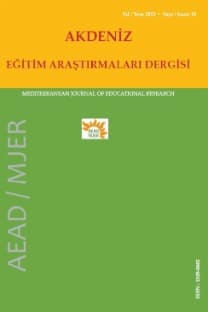Kimya eğitiminde bilgisayar sunumlarının etkili kullanımı ile ilgili öğrenci görüşleri ve algıları
Bu çalışma 2010 yılı Bahar döneminde büyük bir Orta Anadolu üniversitesinin ilköğretim bölümünde gerçekleştirilmiştir. Çalışmaya 77 fen bilgisi öğretmenliği öğrencisi ve 65 sınıf öğretmenliği öğrencisi olmak üzere 142 (51 erkek, 91 bayan) öğrenci katılmıştır. Genel Kimya ve Genel Kimya 4 derslerine katılan öğrencilerin, derslerde kullanılan bilgisayar sunumları ile ilgili görüşleri incelenmiştir. Araştırma sorusu, “genel kimya derslerinde bilgisayar sunumlarının etkili kullanımı ile ilgili öğrenci görüşleri ve algıları nelerdir?” olarak belirlenmiştir. Araştırma metodu olarak eylem araştırması ve veri toplama araçları olarak Likert tipi anket, açık uçlu sorular ve mülakat kullanılmıştır. Araştırma sonunda öğrencilerin bilgisayar sunumlarının sınıfta etkili kullanımı ile ilgili belirgin görüş ve algılara sahip oldukları görülmüştür. Bulgular bilgisayar sunumlarının kimya eğitiminde etkili kullanımı ile ilgili önemli öneriler ortaya koymuştur.
Student views and perceptions of effective computer presentations in chemistry education
This study was conducted in the spring semester of 2010 at the primary education department of a major university in middle Turkey. 77 students from the science education program and 65 students from the elementary education program, in total 142 students (51 male, 91 female) joined the study. The participants’ perceptions about the use of computer presentations in General Chemistry and General Chemistry 4 courses were investigated. The research question was “what are the student perceptions and views about the effective use of computer presentations in general chemistry courses?” Research method was action research, data collection tools were a Likert type questionnaire, open ended questions and interviews. Research findings revealed that students have very particular views and perceptions about the effective use of computer presentations in classrooms. The findings provided useful suggestions regarding how to use computer presentations effectively in chemistry education.
___
Alkan, G. B. (2010). Derslerde PowerPoint sunumu: öğrenci algıları. Uluslararası Öğretmen Yetiştirme Politikaları ve Sorunları Sempozyumu II, 16 - 18 Mayıs 2010, Hacettepe Üniversitesi, AnkaraAlkan, G. B. (2013). PowerPoint ile işlenen derslere eleştirel bir bakış: öğrenci görüşleri. Hacettepe Üniversitesi Eğitim Fakültesi Dergisi [H.U. Journal of Education], 44, 61-72
Aksoy, N. (2003). Eylem araştırması: eğitimsel uygulamaları iyileştirme ve değiştirmede kullanılacak bir yöntem. Kuram ve Uygualmada Eğitim Yönetimi, 36, 474-489
Apperson, J. M., Laws E.L. & Scpansky, J. A. (2006). The impact of presentation graphics on students’ experience in the classroom. Computer & Education, 47, 116-126.
Apperson, J. M., Laws E. L. & Scpansky, J.A. (2008). An assessment of student preferences for PowerPoint presentation structure in undergraduate courses. Computer & Education, 50, 148-153
Bogdan, R. & Biklen, S. K. (2003) Qualitative Research For Education, Boston: Allyn and Bacon.
Carr, W. & Kemmis, S. (1986) Becoming Critical. Education, knowledge and action research, Lewes: Falmer.
Chen, J. & Lin, T. (2008). Does downloading PowerPoint slides before the lecture lead to better student achievement? The International Review of Economics Education, 7(2), 9-18
Daniels, L., Kane, J. & Rosario, B. (2007). The impact of PowerPoint on student performance, course evaluations, and student preferences in economics courses: an experiment at three institutions. Allied Social Science Association Meeting, January 5 – 7, 2007, Chicago, Illinois.
Levasseur, D. G. & Sawyer, J. K. (2006) Pedagogy Meets PowerPoint: A Research Review of the Effects of Computer-Generated Slides in the Classroom, Review of Communication, 6:1-2, 101-123
DenBeste, M. (2003). PowerPoint, Technology and the Web: More than just an overhead projector for the new century? The History Teacher. 36 (4), 491-504
Gelişli, Y. (2009). PowerPoint ile yapılan ders sunumlarının etkililiği. Ahi Evran Üniversitesi Kırşehir Eğitim Fakültesi Dergisi 10 (2), 155-168
Jones, A. M. (2003). The use anda buse of PowerPoint in teaching and learning in life sciences: a personal overview. BEE-J, (2) 04.01.2014 tarihinde http://bio.ltsn.ac.uk/journal/voln/beej-2-3.pdf adresinden erişildi.
Kvavik, R.B., Caruso, J.B., & Morgan, G. (2004). ECAR study of students and information technology 2004: Convenience, connection, and control. Boulder, CO: EDUCAUSE Center for Applied Research. 06.01.2014 tarihinde http://www.educause.edu/ir/library/pdf/ers0405/rs/ers0405w.pdf adresinden erişildi.
Levassaur, D. G. & Sawyer, J. K. (2006). Pedagogy meets PowerPoint: A Research Review on the effects of computer-generated slides in the classroom. Review of Communication, 6, 101-123
Mantei, E. J. (2000). Using Internet Class Notes and PowerPoint in the Physical Geology Lecture. Journal of College Science Teaching, 29(5), 301.
Rickman, J. & Grudzinski, M. (2000). Student Expectation of information technology use in the classroom. Educause Quarterly, 23(1), 24-30.
Smith, M. K. (2007) ‘Action research’, the encyclopedia of informal education. 04.01.2014 tarihinde http://infed.org/mobi/action-research/ adresinden erişildi.
Szabo, A. & Hastings, N. (2000). Using IT in the undergraduate classroom: should we replace the blackboard with PowerPoint? Computers & Education, 35, 175-187.
Yalaki, Y. (2000). Finding effective ways of using computer presentations in Chemistry education. Yayımlanmamış yüksek lisans tezi, Florida Eyalet Üniversitesi, Müfredat ve Öğretim Bölümü, Tallahassee, Florida, ABD.
Yılmazel-Şahin, Y.(2009). A comparison of graduate and undergraduate teacher education students’ perceptions of their instructors’ use of Microsoft PowerPoint. Technology, Pedagogy and Education, 18 (3), 361-380
- ISSN: 1309-0682
- Yayın Aralığı: Yılda 4 Sayı
- Başlangıç: 2008
- Yayıncı: Tayfun Taşbilek
